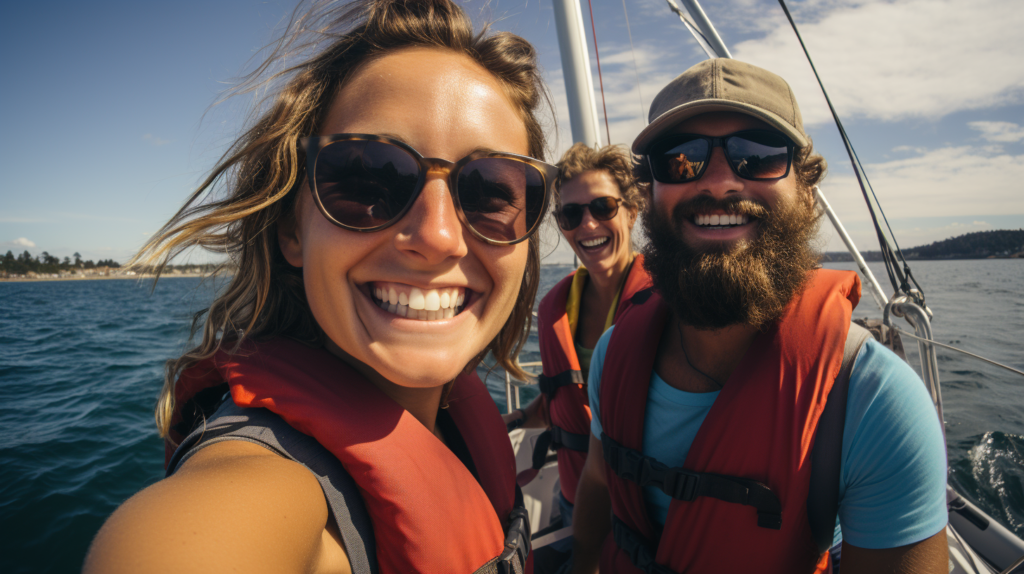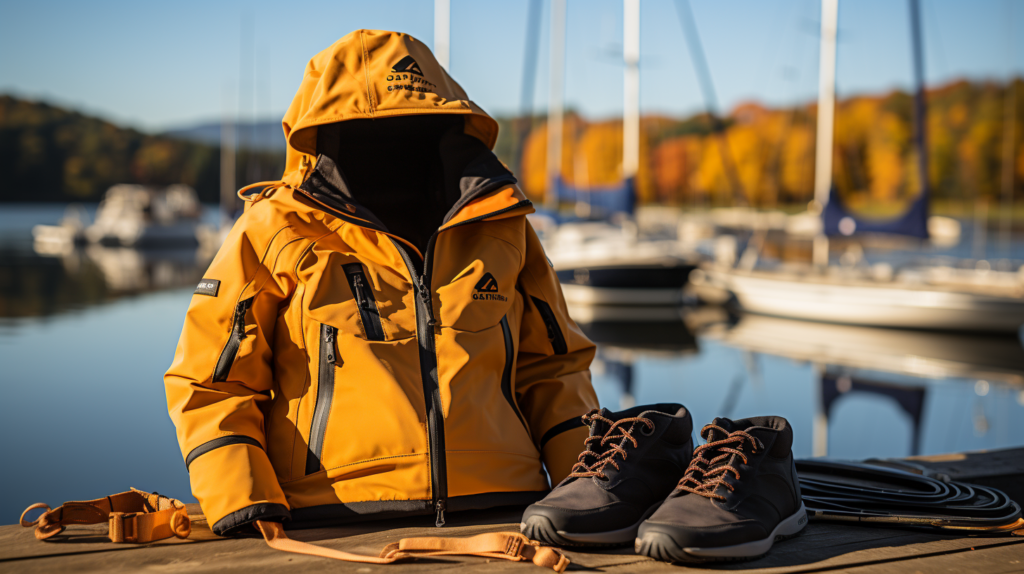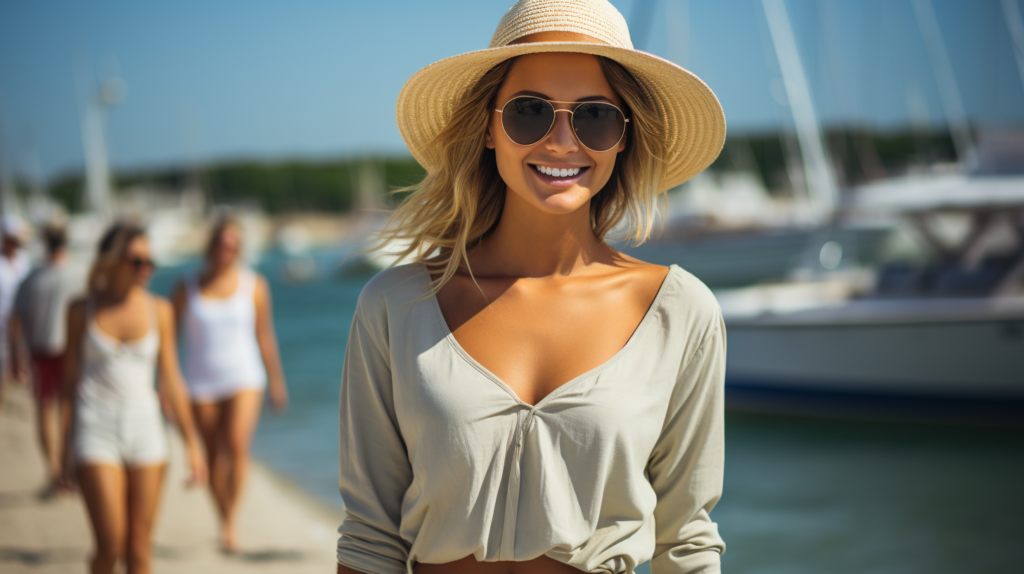Table of Contents
Table of Contents

Ever wondered what should you wear to sailing lessons? Choosing suitable gear can be challenging, especially when you’re new to the world of boating. This guide aims to simplify this task by helping you decide on the most comfortable and weather-appropriate outfits for your adventure at sea.
Ready to dive in? Let’s set sail!
Key Takeaways
- Choose suitable clothing like a wetsuit, waterproof spray top, gloves, boots, and a buoyancy aid for comfortable and safe sailing lessons.
- Consider the weather and temperature when selecting your outfit. Layering allows you to adapt to changing conditions.
- Pack essential items like raincoat, waterproof trousers, sailing jacket, trainers, or flip flops made of neoprene/rubber. Bring gloves for extra grip and protection. Wear polarized sunglasses for better visibility and face buffs for comfort and sunburn protection.
- Use sturdy luggage bags and a convenient day pack to carry your essentials on board while prioritizing comfort over style in choosing sailing clothing.
Choosing the Right Clothing for Sailing Lessons

Wear a wetsuit for cold weather, a waterproof spray top, sailing gloves, sailing boots, and a buoyancy aid to ensure comfort and safety during your sailing lessons.
Wetsuit for cold weather
Harsh, cold weather demands the right gear for sailors, and a neoprene wetsuit stands as an ideal choice. The primary purpose of this suit is to offer insulation against chilling wind and freezing water temperatures – it even allows you to stay warm when submerged! These suits create thermal protection by trapping a layer of water between your skin and the fabric, which then heats up from your body heat.
Neoprene also does wonders in safeguarding against possible abrasions or cuts that might occur during sailing lessons. So, with both warmth and defense covered excellently, investing in a good-quality neoprene wetsuit can make your sailing experience comfortable and pleasant on those colder days out at sea.
Waterproof spray top
If you’re gearing up for sailing lessons, don’t overlook the importance of a waterproof spray top. This lightweight jacket with a turtleneck is your first line of defense against wind and water on deck.
Made from synthetic fabrics like GORE-TEX, these sailing tops offer superior protection while retaining comfort and flexibility.
One advantage of wearing a waterproof spray top is that it keeps you dry without sacrificing breathability. The last thing you want during intense sailing lessons is to feel clammy inside your outfit! With its fast-drying features, the spray top can handle splashes or downpours yet still keep moisture at bay.
Having this item as part of your nautical clothing ensemble ensures you are well-prepared for whatever weather comes your way out in the open sea.
Sailing gloves
Gloves play a crucial role in any sailor’s outfit. Made from materials like cotton and wool for summer outings, they provide excellent grip and reduce hand fatigue even in wet conditions.
In colder seasons, merino or thick wool-made gloves keep hands warm while maintaining freedom of movement. Both men’s sailing shirts and women’s sailing clothes are greatly complemented by these functional accessories which work to enhance comfort and efficiency while on the water.
Whether you’re sporting a casual boating outfit or full women’s sailing clothing, including these gloves in your ensemble will prove beneficial. They are recommended for sailing in all seasons – proving that they aren’t just an addition to your yacht clothing but a necessity!
Sailing boots
Sailing boots are an essential piece of gear for any sailor. Made from waterproof materials like neoprene and rubber, these boots keep your feet dry and provide warmth and grip on wet surfaces.
Whether you’re sailing in the summer or winter, sailing boots are a must-have to protect your feet and ensure traction on a sailboat. These boots are commonly used alongside other sailing clothing and gear to provide full protection while out on the water.
Buoyancy aid
A buoyancy aid is an essential piece of gear for sailors, providing floatation and helping you stay afloat in the water. It is designed to distribute the weight evenly across your body and improve your swimming position.
Whether you are a beginner or an experienced sailor, wearing a buoyancy aid gives you added safety and peace of mind while out on the water. Remember to choose one that fits well and is approved by relevant safety regulations.
Stay safe and enjoy your sailing adventures!
Other essentials
- A waterproof watch to keep track of time while on the water
- A hat or cap to protect your head from the sun
- Sunblock protection with a high SPF to protect your skin from harmful UV rays
- A whistle or horn for emergencies and signaling
- A dry bag to keep your belongings safe and dry
- Binoculars for observing wildlife or other boats in the distance
- Snacks and water to stay hydrated during your sailing lessons
What to Wear for Different Seasons and Locations

Consider the weather and temperature when choosing what to wear for sailing lessons.
Consider the weather and temperature
Choose your sailing attire based on the weather and temperature conditions you will encounter. Layering is key to staying comfortable and prepared for changing conditions. If it’s cold, opt for merino leggings, a woolen jersey, and a puffer jacket to stay warm.
For wind and rain, wear a windproof jacket or waterproof spray top to keep dry. In warmer weather, lightweight and permeable fabrics like cotton or athleisure leggings are ideal. Remember to always check the forecast before setting sail to ensure you are dressed appropriately for the conditions ahead.
Layering for versatility
Layering is essential when it comes to sailing, as it allows you to adapt to changing weather conditions and stay comfortable throughout your lesson. By wearing multiple layers, you can easily add or remove clothing as needed.
Start with a base layer made of natural fabrics like wool or cotton, which are porous and biodegradable. Next, add wind and waterproof layers made from synthetic fabrics like GORE-TEX to protect yourself from the elements.
Avoid wearing denim, as it doesn’t dry quickly or provide warmth when wet. Remember that layering gives you versatility on the water, so you can focus on enjoying your sailing experience without worrying about being too hot or too cold.
Sun protection
Protecting your skin from the sun’s harmful rays is essential when you’re out on the water. Sunscreen should be a top priority, especially since UVA rays can lead to premature wrinkles and increase the risk of skin cancer.
Make sure to choose a sun cream with at least SPF 30 or higher for maximum protection. Apply it generously all over your exposed skin, including your face, neck, arms, and legs. And don’t forget to reapply every two hours or after swimming!
Recommended Sailing Gear
Don’t forget to pack a raincoat, waterproof trousers, and a suitable sailing jacket for the best sailing experience.
Raincoat
A raincoat is an essential piece of gear to have when sailing, especially in unpredictable weather conditions. Made from waterproof materials like GORE-TEX, a good quality raincoat will keep you dry and protected from the rain and wind.
It’s important to choose a raincoat that fits well and allows for freedom of movement, as you’ll need to maneuver the boat while wearing it. Additionally, make sure your raincoat has a hood or a way to protect your head from getting wet.
So don’t forget to pack your trusty raincoat before heading out on your sailing adventure!
Waterproof trousers
Water-resistant trousers are a crucial part of your marine gear. Made from synthetic fabrics like GORE-TEX, these trousers provide essential protection against wind and water. They are designed to keep you dry even in the wettest conditions.
Comfort is key when choosing Impermeable trousers for sailing, so look for ones that fit well and allow for freedom of movement. Remember to prioritize functionality over style when it comes to selecting your sailing clothing.
Proper sailing jacket
For optimal comfort and protection during sailing lessons, it is essential to wear a proper sailing jacket. These jackets are designed with wind and water-repellent materials like GORE-TEX, ensuring that you stay dry even in rough weather conditions.
The synthetic fabrics used also allow for breathability so you won’t overheat while out on the water. Make sure your sailing jacket fits well and has adjustable cuffs and hems to seal out any water or cold air.
With the right sailing jacket, you’ll be able to focus on honing your skills without worrying about getting wet or chilly.
Trainers or flip-flops for footwear
Sailors should avoid wearing trainers or flip-flops for footwear during sailing lessons. These types of shoes do not provide the necessary grip and support needed on a boat. Instead, it is recommended to wear sailing boots or shoes made of moisture-resistant materials like neoprene and rubber.
These specialized footwear options offer better traction and protection against water, ensuring a safer and more comfortable experience while out at sea. Comfort is key when choosing the right clothing for sailing, so it’s important to prioritize functionality over style when it comes to footwear choices.
Additional Gear for Comfort and Protection
Gloves provide extra grip and protect your hands from rope burn, while polarized sunglasses help reduce glare from the water and protect your eyes. Face buffs can also come in handy for protecting your face from sunburn or windburn.
Gloves
Sailing gloves are a must-have accessory for sailors of all levels. These gloves provide comfort and protection while out on the water. Made from durable and water-resistant materials, they offer a secure grip even in wet conditions.
Sailing gloves also help prevent hand fatigue and protect against blisters and abrasions. Whether you’re a beginner or an experienced sailor, wearing gloves can greatly enhance your sailing experience by ensuring that your hands stay comfortable and well-protected throughout your lesson or voyage.
Polarized sunglasses
Polarized sunglasses are an important addition to your nautical attire for both comfort and protection. These specialized sunglasses help reduce glare from the water, making it easier for you to see clearly on sunny days.
They also provide UV protection, shielding your eyes from harmful rays. By wearing polarized sunglasses, you can enjoy better visibility while safeguarding your eyes from the sun’s harsh glare.
Don’t forget to pack a pair before heading out on your sailing lessons!
Face buffs
Face buffs are a recommended accessory for sailors during lessons. They offer comfort and protection against wind, sun, and cold temperatures while out on the water. Made from lightweight and permeable materials like polyester or spandex, face buffs are designed to be moisture-wicking for added comfort.
Not only do they provide relief from the elements, but they also offer protection against harmful UV rays, reducing the risk of sunburn. With their versatility and practicality, face buffs are a must-have item for any sailor looking to stay comfortable and protected during their sailing lessons.
What to Bring On board
Pack your essentials in sturdy luggage bags and bring a convenient day pack for easy access to items on the boat. Don’t forget to include clothes for when you’re back on land, ensuring you have everything you need for a successful sailing lesson.
Luggage bags
When it comes to sailing, having the right luggage bags is essential for a smooth and organized trip. Opt for water-resistant bags to protect your belongings from getting wet.
Consider choosing bags with multiple compartments or pockets to help keep your items organized and easily accessible. Additionally, look for bags that are lightweight and easy to carry, as you may need to transport them between different boats or marinas.
Remember, investing in durable luggage bags will ensure that your gear stays safe and secure during your sailing adventures.
Day packs
Day packs are essential for any sailor to carry their belongings onboard. A day pack is a small backpack that allows you to keep your essentials close at hand while sailing. It should be lightweight, water-resistant, and comfortable to wear.
In your day pack, you can store items like sunscreen, snacks, a water bottle, a hat or visor for sunblock protection, sunglasses with polarized lenses to reduce glare on the water, and any personal items you may need during your time on the boat.
Having a day pack ensures that all your necessities are within reach so that you can fully enjoy your sailing experience without worrying about having everything scattered around the boat or getting wet from splashing waves.
Clothes for on-land
When you’re participating in sailing lessons, it’s important to have the right clothing not only for when you’re out on the water but also for when you’re on land. Opt for comfortable and practical attire that offers freedom of movement.
Consider wearing lightweight shorts or pants made from quick-drying materials, along with a breathable t-shirt or polo shirt. Bring a sweater or jacket in case the weather turns chilly, and don’t forget to pack a hat and sunglasses to protect yourself from the sun’s rays.
Conclusion and Final Tips
Choose the right clothing for sailing lessons to ensure comfort and safety. Layering is important to adapt to changing weather conditions. Don’t forget essentials like a wetsuit, waterproof spray top, gloves, and boots.
Consider the season and location when selecting your outfit. Bring spare clothes in case you get wet. Prioritize comfort over style and opt for airy fabrics like cotton or wool.
Stay prepared with wind and watertight layers made from synthetic materials. Enjoy your sailing lessons with the right gear!
FAQs
1. What should you wear to sailing lessons?
When going for sailing lessons, it’s important to wear the right sailing attire to ensure your comfort and safety on the water. This includes sailing gear such as a sailing jacket, weather gear, a good pair of sailing boots, and sailing gloves.
2. Are there specific men’s outfits for sailing lessons?
Yes, there is a variety of men’s sailing outfits available that are both functional and stylish which can be worn during your lessons.
3. Are there different women’s clothing options for sailing lessons?
Absolutely! Women have several options when it comes to what to wear sailing, including various types of women’s sail clothes or more specialized pieces like the right kind of boat ride outfits or specific items like ‘sailing clothing for women’.
4. Is there a standard uniform or outfit across all genders for Sailing Lessons?
No definitive uniform exists as such but comfort and safety must guide your choice – whether it’s menswear or womenswear – always opt for practicality over style when selecting your sail clothes.
5. What should I wear if I don’t have any sailing clothes?
If you don’t have any sailing-specific clothing, you can still dress appropriately by wearing lightweight, breathable layers that can keep you warm and dry. Opt for clothes that won’t restrict your movement and can provide sun protection such as a hat and sunscreen.
6. Can I wear regular clothes when going sailing?
While you can technically wear regular clothes for sailing lessons, it’s always a good idea to invest in appropriate sailing attire. Regular clothes may not provide the necessary protection or flexibility needed for sailing activities.
7. What are the essential items for a sailing outfit?
An essential sailing outfit typically includes a base layer, a comfortable pair of pants or shorts, a breathable shirt or jacket, gloves, sunglasses, a sun hat, and a good pair of sailing shoes or boots.
8. Should I dress differently depending on the weather conditions?
Yes, you should dress differently depending on the weather conditions. If it’s colder or windy, you’ll want to wear layers and have additional warm clothing to keep you comfortable. If it’s hot and sunny, focus on wearing lightweight and sun-protective clothing.
9. What should I not wear onboard?
Avoid wearing heavy or bulky clothing that can restrict your movement, as well as jeans or cotton materials that can get wet and make you feel cold. It’s also best to avoid wearing any shoes with a slippery sole that can be hazardous on a sailboat.
10. What kind of footwear should I wear on a sailboat for sailing lessons?
For sailing lessons, it’s recommended to wear non-slip, comfortable, and quick-drying sailing shoes or boots. These will provide a good grip on wet surfaces and protect your feet.
11. Do sailors wear sunglasses while sailing?
Yes, wearing sunglasses while sailing is highly recommended to protect your eyes from the sun’s glare and potential water spray.
12. Can I wear sailing gloves while sailing?
Yes, you can wear sailing gloves while sailing. They are specifically designed to provide better grip, protect your hands, and enhance your performance while handling ropes and other sailing equipment.
13. What are the benefits of wearing sailing gloves?
Wearing sailing gloves offers several benefits. Firstly, they provide extra grip, allowing you to maintain better control over the ropes and rigging. Additionally, they protect your hands from blisters, calluses, and rope burns, ensuring you have a comfortable sailing experience. Lastly, sailing gloves also help keep your hands warm in cold and wet conditions.
14. Are sailing gloves waterproof?
Most sailing gloves are designed to be water-resistant, meaning they can protect your hands from getting soaked. However, it is important to check the product specifications to ensure the gloves you choose offer the desired level of waterproofing.
15. Will wearing sailing gloves keep me warm?
Yes, wearing sailing gloves can help keep your hands warm while sailing. They provide an additional layer of insulation, preventing heat loss and protecting your hands from the cold wind and water.
16. Can I wear a sailing jacket for activities other than sailing?
Yes, you can certainly wear a sailing jacket for activities other than sailing. Sailing jackets are designed to protect from wind, water, and cold temperatures, making them suitable for various outdoor activities and sports.
17. What are the key features to look for in a sailing jacket?
When choosing a sailing jacket, look for features such as waterproof or water-resistant material, breathability, warmth insulation, adjustable cuffs, a high collar with a hood, and multiple pockets for storage. These features ensure comfort and protection while out on the water.
18. Can I wear sailing boots when going sailing?
Yes, sailing boots are specially designed to be worn while sailing. They offer protection and functionality to sailors in various sailing conditions. Whether you are cruising on a yacht or racing on a dinghy, wearing sailing boots is highly recommended.
19. Are sailing boots waterproof?
Yes, sailing boots are typically made with waterproof materials. They are designed to keep your feet dry even when exposed to water during sailing activities. Waterproof boots are essential for maintaining comfort and preventing discomfort caused by wet feet.
20. Should I wear layers while sailing?
Yes, it is recommended to wear layers while sailing. Layering your clothing helps to regulate your body temperature and keeps you comfortable in changing weather conditions.
21. What are the benefits of wearing layers while sailing?
Wearing layers offers several benefits while sailing. Firstly, it allows you to add or remove clothing as needed, depending on the temperature. This helps to avoid overheating or getting too cold. Additionally, layering provides better insulation, as the air trapped between layers serves as an insulating barrier.
22. Do I need to consider the wind factor when layering for sailing?
Yes, considering the wind factor is important when layering for sailing. The outer layer of your clothing should be windproof to protect you from the wind chill. Windproof materials help to maintain your body heat and keep you comfortable while sailing.

